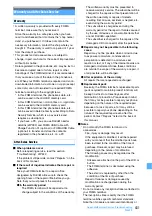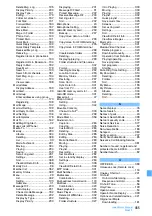
442
Appendix/External Devices/Troubleshooting
Declaration of Conformity
This mobile phone complies with the EU requirements
for exposure to radio waves.
Your mobile phone is a radio transceiver, designed and
manufactured not to exceed the SAR* limits** for
exposure to radio-frequency (RF) energy, which SAR*
value, when tested for compliance against the standard
was 0.587 W/kg. While there may be differences
between the SAR* levels of various phones and at
various positions, they all meet*** the EU requirements
for RF exposure.
*
The exposure standard for mobile phones employs
a unit of measurement known as the Specific
Absorption Rate, or SAR.
** The SAR limit for mobile phones used by the public
is 2.0 watts/kilogram (W/kg) averaged over ten
grams of tissue, recommended by The Council of
the European Union. The limit incorporates a
substantial margin of safety to give additional
protection for the public and to account for any
variations in measurements.
*** Tests for SAR have been conducted using standard
operating positions with the phone transmitting at its
highest certified power level in all tested frequency
bands. Although the SAR is determined at the
highest certified power level, the actual SAR level of
the phone while operating can be well below the
maximum value. This is because the phone is
designed to operate at multiple power levels so as
to use only the power required to reach the network.
In general, the closer you are to a base station
antenna, the lower the power output.
FCC RF Exposure Information
Your handset is a radio transmitter and receiver.
It is designed and manufactured not to exceed the
emission limits for exposure to radio frequency (RF)
energy set by the Federal Communications
Commission of the U.S. Government.
The guidelines are based on standards that were
developed by independent scientific organisations
through periodic and thorough evaluation of scientific
studies. The standards include a substantial safety
margin designed to assure the safety of all persons,
regardless of age and health.
The exposure standard for wireless handsets employs
a unit of measurement known as the Specific
Absorption Rate, or SAR. The SAR limit set by the FCC
is 1.6 W/kg.
The tests are performed in positions and locations
(e.g., at the ear and worn on the body) as required by
the FCC for each model. The highest SAR value for
this model handset when tested for use at the ear is
0.394 kg and when worn on the body, as described in
this user guide, is 0.271 W/kg.
Body-worn Operation; This device was tested for
typical body-worn operations with the back of the
handset kept 1.5 cm from the body. To maintain
compliance with FCC RF exposure requirements, use
accessories that maintain a 1.5 cm separation distance
between the user’s body and the back of the handset.
The use of belt clips, holsters and similar accessories
should not contain metallic components in its
assembly.
The use of accessories that do not satisfy these
requirements may not comply with FCC RF exposure
requirements, and should be avoided.
The FCC has granted an Equipment Authorisation for
this model handset with all reported SAR levels
evaluated as in compliance with the FCC RF emission
guidelines. SAR information on this model handset is
on file with the FCC and can be found under the
Display Grant section of http://www.fcc.gov/oet/fccid
after searching on FCC ID BGBMTOWM07GOR25.
Additional information on Specific Absorption Rates
(SAR) can be found on the Cellular
Telecommunications & Internet Association (CTIA)
website at http://www.phonefacts.net.
NOTE: This equipment has been tested and found to
comply with the limits for a Class B digital device,
pursuant to Part 15 of the FCC Rules. These limits are
designed to provide reasonable protection against
harmful interference in a residential installation. This
equipment generates, uses and can radiate radio
frequency energy and, if not installed and used in
accordance with the instructions, may cause harmful
interference to radio communications. However, there
is no guarantee that interference will not occur in a
particular installation. If this equipment does cause
harmful interference to radio or television reception,
which can be determined by turning the equipment off
and on, the user is encouraged to try to correct the
interference by one or more of the following measures:
・
Reorient or relocate the receiving antenna.
・
Increase the separation between the equipment and
receiver.
・
Connect the equipment into an outlet on a circuit
different from that to which the receiver is connected.
・
Consult the dealer or an experienced radio/TV
technician for help.
The product “FOMA D905i” is declared to conform
with the essential requirements of European Union
Directive 1999/5/EC Radio and Telecommunications
Terminal Equipment Directive 3.1(a), 3.1(b) and 3.2.
Summary of Contents for FOMA D905I
Page 1: ......
Page 446: ...444 MEMO...
Page 447: ...445 MEMO...
Page 448: ...446 MEMO...
Page 449: ...447 MEMO...
Page 450: ...448 MEMO...
Page 451: ...449 MEMO...
Page 452: ...450 MEMO...
Page 453: ...451 Index Quick Manual Index 452 Quick Manual 458...






























